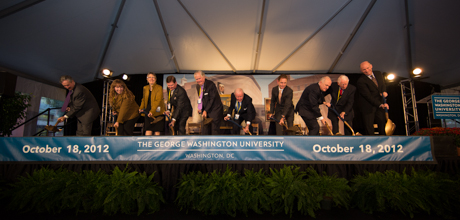President Steven Knapp and Provost Steven Lerman joined representatives of The Textile Museum, Albert H. Small, GW Board of Trustees members and other university leaders to help break ground for the George Washington University Museum at a special ceremony Thursday evening in University Yard.
Slated to open in fall 2014, the George Washington University Museum will be the home of The Textile Museum, the Albert H. Small Washingtoniana Collection and the university’s existing collection of fine art. The new museum will be a custom-built, approximately 35,000-square-foot building located at G and 21st streets.
The groundbreaking—held just steps away from the new museum’s future location —featured remarks from Dr. Knapp and Dr. Lerman, GW Chairman of the Board of Trustees W. Russell Ramsey, B.B.A. ’81; Jeffrey Akman, interim vice provost for health affairs and dean of GW’s School of Medicine and Health Sciences; and GW trustee Robert G. Perry, B.S. ’70, chairman and president of the National Trust for the Humanities.
Albert H. Small, president of Southern Engineering Corporation; arts patron Luther W. Brady, B.A. ’46, M.D. ’48; and Bruce P. Baganz, president of the Board of Trustees of The Textile Museum were also honored at the event with the unveiling of artwork illustrative of their collections. Mr. Small helped unveil a portrait of himself that will be displayed in the new museum, and Dr. Brady helped unveil a reproduction of the Gilbert Stuart portrait of George Washington from the GW Collection. Dr. Baganz helped unveil a reproduction of a 19th-century man’s caftan from central Asia from The Textile Museum collection, which holds more than 19,000 objects.
The new museum will occupy a historic location on the Foggy Bottom Campus, said Dr. Knapp. One hundred years ago, in 1912, the university moved to Foggy Bottom at G Street between 20th and 21st streets— where the new museum will be located.
“I think the fact that we’re going to be placing this extraordinary museum right in the heart of our campus and right at the point origin of our campus in Foggy Bottom is symbolically appropriate,” said Dr. Knapp. “It will bring together two anchor collections--the Albert H. Small Washingtoniana Collection and The Textile Museum-- and provide new opportunities for exhibitions of our art collections, particularly the Luther W. Brady Collection.”
“[The new museum] will be a vibrant site for exhibitions, lectures and public programming for students, educators, the general public and scholars,” said Dr. Knapp. “I think it will attract visitors and scholars from around the world, because we are bringing word-class collections to the heart of our university campus.”
Dr. Knapp also noted the nearby location of the 156-year-old Woodhull House, where Mr. Small’s Washingtoniana Collection will be permanently displayed as part of the new museum. The house was donated to the university in 1921 by Gen. Maxwell Van Zandt Woodhull, a university trustee and benefactor who was influential in the university’s decision to move to Foggy Bottom. It will be renamed the Historic Woodhull House, Home of the Albert H. Small Washingtoniana Collection. A prominent space in the Woodhull House will be named the Albert H. Small Center for National Capital Area Studies.
Dr. Knapp also announced members of the board of directors of the new museum, which included Dr. Baganz, Mr. Perry, art historian and writer Ann Fensterstock; Ruth Perlin, one of the founding members of the Friends of the Luther W. Brady Art Gallery; Sandy Crary, member of The Textile Museum Board of Trustees; Cynthia Boyer, vice president of The Textile Museum Board of Trustees; and Dr. Brady.
Mr. Ramsey called the groundbreaking of the new museum a “prestigious chapter” in the university’s history, noting the collaborations, scholarship and interdisciplinary opportunities the new museum will provide the university and the community, and the “real interest” the museum will attract locally and internationally.
Dr. Akman, a founding member and co-chair of the Friends of the Luther W. Brady Art Gallery, spoke about GW’s permanent collection of more than 3,800 objects, some of which will be displayed in the new museum.
“With the birth of the GW Museum, this collection will find an expanded home, and have the opportunity to be seen by a wider community and to reach new heights,” he said.
In his remarks, Mr. Perry praised Mr. Small’s desire to share his historic collection with future generations, stating that the university was “very much appreciative” of Mr. Small’s generosity. The university recently hosted the Albert H. Small Washingtoniana Symposium, which this year highlighted the District’s role in the Civil War.
Dr. Lerman told the audience that the new museum will be a vibrant place that will offer GW students “an incredible range of opportunities.”
“This is going to be an amazing place and amazing collections will reside within it,” he said. “A living museum is one that integrates scholarly research, teaching and collections together, and that really is the ambition of this wonderful new museum.”
On Nov. 15, the university will break ground on a 20,000-square-foot conservation and collections resource center on its Virginia Science and Technology Campus in Loudoun County, Va. The conservation center will be a dedicated space for the study and care of The Textile Museum collection, the Albert H. Small Washingtoniana Collection and GW’s permanent collection.


